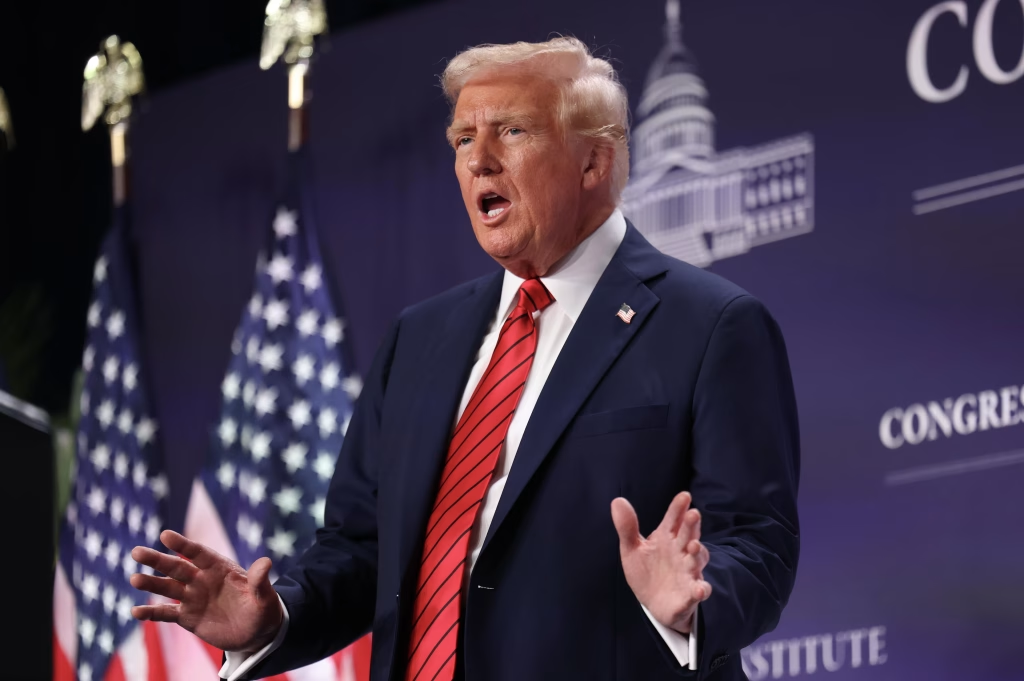Donald Trump’s sweeping tariffs on countries such as Canada, Mexico, and China have raised questions about whether the American public will be willing to bear the economic burden. His aggressive trade strategy, which includes imposing hefty tariffs, is meant to bring about significant changes in global trade dynamics, but it might come at a cost that many Americans were not prepared for.
Trump’s Bold Claim on Tariffs: “Pain” and Price to Pay
Over the weekend, Trump posted a message about the tariffs, stating, “WILL THERE BE SOME PAIN? YES, MAYBE (AND MAYBE NOT!) BUT WE WILL MAKE AMERICA GREAT AGAIN, AND IT WILL ALL BE WORTH THE PRICE THAT MUST BE PAID.” This message, while confident in tone, has stirred debate about whether the American public is truly ready to accept the financial consequences of his decisions.
The concept of “pain,” in the form of higher prices on imported goods, is something Trump seems willing to tolerate in the hopes of protecting domestic industries and reshaping the American economy. However, this approach raises questions about just how much pain people are willing to endure, especially when the cost of living could rise in response to these tariffs.
Retaliation from Canada and Other Countries
After the implementation of tariffs, Canada responded with retaliatory measures, which further deepened concerns about the ripple effect of the U.S. tariffs. Fox News compiled a list of 23 goods that will now see higher prices for American consumers due to these international countermeasures. Items on the list include staples like crude oil, beer, avocados, maple syrup, ground beef, cooking oil, and even cars. For many Americans, these goods represent everyday purchases, making the increased prices personal and potentially burdensome.
Canada’s counter-tariffs have created a complex situation, one that places the financial strain on consumers, many of whom were not initially aware of the price hikes that could follow from these international disputes. As a result, the idea of economic “pain” being a price worth paying is beginning to be questioned by many, even among Trump’s supporters.
The Disconnect: Trump’s Promise vs. Voters’ Reality
Trump campaigned on promises of lowering prices and making life easier for everyday Americans. His “Make America Great Again” slogan was largely built on the idea of revitalizing American manufacturing, creating jobs, and lowering costs. However, the tariffs – which were intended to protect U.S. businesses from foreign competition – may go against this central promise, especially if they lead to higher prices on goods that Americans regularly consume.
Aaron Blake, senior political reporter for The Washington Post, pointed out that Trump’s rhetoric may be out of sync with what voters are actually willing to endure. While there is still some support for tariffs, the reality of rising prices may cause many to reconsider their position.
The Polls: Public Opinion on Tariffs
Blake cited a survey from YouGov that showed a divided opinion among Americans on the subject of tariffs. About 29 percent of Americans wanted tariffs to be increased, 27 percent wanted them to stay the same, and 18 percent wanted them reduced. While this shows a certain level of support for Trump’s strategy, the situation becomes more complicated when voters are asked about the potential economic fallout.
The YouGov survey continued by asking respondents whether they would still support increased tariffs if it meant higher prices for consumers. The results were revealing: only 52 percent of those who initially supported increasing tariffs were willing to continue backing them when faced with the prospect of paying higher prices.
Moreover, a Reuters-Ipsos poll found that just 9 percent of Americans “strongly” supported increasing tariffs, even if they led to higher prices. This suggests that while a vocal portion of the population supports the president’s trade war, the broader public may not share the same enthusiasm if it means their grocery bills, gas prices, and other everyday expenses go up.
The Fallout: Trump’s Tariffs and Their Unintended Consequences
The backlash from higher prices is not just a theoretical concern; it’s a reality that could hit Trump’s base particularly hard. The president’s supporters often include middle- and working-class Americans, many of whom may find themselves paying more for basic goods due to the tariffs.
In addition to the direct price increases, there is the issue of market instability. As businesses feel the strain from higher input costs, some may be forced to cut back on operations, leading to potential job losses. The increased costs of goods could also exacerbate inflation, which would affect everyone, not just those directly impacted by the tariffs.
Furthermore, Trump’s messaging has painted the tariffs as a win-win situation – where both American jobs are protected, and prices remain stable. However, this optimistic outlook may be difficult to maintain if the public begins to feel the economic pressure, particularly if they are forced to pay higher prices for things they need every day.
The Real Test: How Much “Pain” Will Americans Endure?
Blake concluded that Trump’s tariffs could ultimately lead to a major test of public support. The president’s supporters may have initially bought into the idea that higher tariffs would help the U.S. economy in the long run. However, the reality of the situation may not align with their expectations. If the pain from higher prices becomes too great, or if the economic benefits of the tariffs don’t materialize as promised, Trump could find himself in a difficult position with voters.
The president’s decision to implement sweeping tariffs was based on the idea of leveraging trade policies to revitalize domestic industries. However, as the tariffs start to impact daily life, it is becoming increasingly clear that the costs associated with them may not be as easily brushed off. The question remains: How much financial “pain” will Americans tolerate before they start to demand change?
Conclusion
Donald Trump’s tariffs, while intended to protect American industries and promote economic growth, could have unintended consequences. The financial strain that Americans face from rising prices could lead to a reevaluation of the president’s trade policies, especially as more goods become subject to retaliatory tariffs. While the idea of paying a “price” for the greater good may resonate with some, many Americans may find the reality of higher prices hard to accept. As the economic fallout unfolds, it will be interesting to see whether the American public remains supportive of these tariffs, or if they begin to demand a change in direction.
Disclaimer – Our editorial team has thoroughly fact-checked this article to ensure its accuracy and eliminate any potential misinformation. We are dedicated to upholding the highest standards of integrity in our content.





More Stories
Americans Face Rising Costs as Trump’s Tariffs Bite
Americans Face Rising Costs as Trump’s Tariffs Bite
Americans Face Rising Costs as Trump’s Tariffs Bite